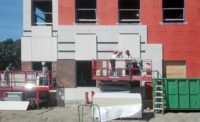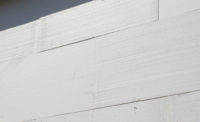Given the growing adoption of rigorous energy codes, most wall professionals have encountered the need to use continuous insulation in commercial buildings. According to ASHRAE 90.1, Energy Standard for Buildings Except Low-Rise Residential Buildings, CI is “Insulation that is continuous across all structural members without thermal bridges other than fasteners and service openings.”
The exception for fasteners is largely a matter of practical necessity, because components of the wall assembly must be attached together somehow, of course. But, to maximize a wall’s energy efficiency, it is important to remember that some cladding attachment systems do a better job of minimizing thermal bridges, than do other attachment methods.
This article explores the pros and cons of various common cladding attachment systems and how composite insulation/structural wall panels provide an alternate wall assembly method that helps keep CI continuous.
Cladding System Fastener Evolution
Wall professionals have several options for supporting and attaching exterior wall cladding through the CI layer to the underlying structure. Attachment systems have evolved over time, ever striving towards the goal of supporting the cladding, while including as few thermal bridges as possible.
Steel Z girts were the first and most intuitive attempt to bridge the exterior CI. The idea of having a stud to attach to was deeply entrenched and the natural move was to extend the stud outwards. Girts are relatively easy to use—either horizontally or vertically—and provide a large cladding attachment area (up to a quarter of the wall surface). However, the large cladding attachment area also results in substantial thermal bridging through the steel.
Rail systems represent the second generation of CI fastening systems, and attempt to keep the support offered by Z Girts while removing some of the thermal bridging. This is accomplished by placing the rails over the insulation and screwing through the foam to the framing. The number of fasteners should be engineered to support the cladding weight. Benefits of rails include rigidity, reduced thermal bridging and a large attachment area. These products are typically only available for use with rigid foam board CI options, and may vary in price and complexity.
Clips were developed to further reduce thermal bridging beyond Z girts. Clips are commonly either an abbreviated composite girt returning to stud non-continuously, or a small member attached back to the studs through the CI. Typically horizontal or vertical rails are attached to the clips outside the insulation for the cladding attachment. Numerous clip options are available, and they have the benefit of reduced thermal bridging compared to standard Z girts. A primary drawback is the limited attachment area provided.
Composite Z girts were the first CI attachment systems to use an alternate material composition, intended to have lower heat flow than steel. These systems offer significantly better thermal performance than steel but may have specialized installation details.
Advent of Composite Insulation Panels
To further reduce thermal bridging for cladding attachment, insulation manufacturers have developed composite products that combine rigid foam insulation with wood structural panels. One example is panels comprised of polyisocyanurate insulation bonded to plywood or oriented strand board.
In such composite insulation panels, the entire plywood or OSB surface can be used as a cladding attachment point, which greatly simplifies cladding installation compared to trying to align fasteners with a girt, clip or rail. Additionally, while the composite insulation panel is secured firmly to the base wall, the cladding attachment is thermally broken by being attached to the wood of the composite panel.
In some cases, composite insulation panels, are made with fire-treated plywood and can be used in NFPA 285 compliant assemblies, for a multi-performance wall system. In many NFPA 285 compliant assemblies the gypsum sheathing layer behind the insulation can be eliminated, if desired, allowing for thinner wall profiles and reduced costs; check with the manufacturer for details.
Fastening Composite Insulation Panels
While rigid foam/wood panel composite insulation products reduce overall fastener penetrations to the base wall system, it is essential to fasten them according to the manufacturer’s requirements. Proper fastening helps ensure adequate support of both the insulation and the cladding.
The number of fasteners and fastening pattern required depend on the base wall composition (wood stud, steel stud, concrete, CMU), framing spacing, insulation thickness and cladding weight. The fastening schedule also might vary if the composite insulation panels are installed horizontally or vertically, so it is important to confirm details with the manufacturer. Insulation manufacturers also usually specify which types of fasteners are required with their various panels.
In some cases, the insulation manufacturer will recommend specific drill speeds for mechanical fastener installations. With some fasteners, higher drill speeds create excess heat from friction and can cause the fasteners to soften and lose their edge, thereby slowing installation.
Conclusion
Although no cladding fastening system is right for every wall, composite insulation panels offer the ability to meet a range of needs—from simplified attachment of cladding to NFPA 285 compliance. As energy codes become increasingly strict, wall professionals can expect that code writers will leave no part of the building envelope unexamined, including the cladding fastening.








Report Abusive Comment